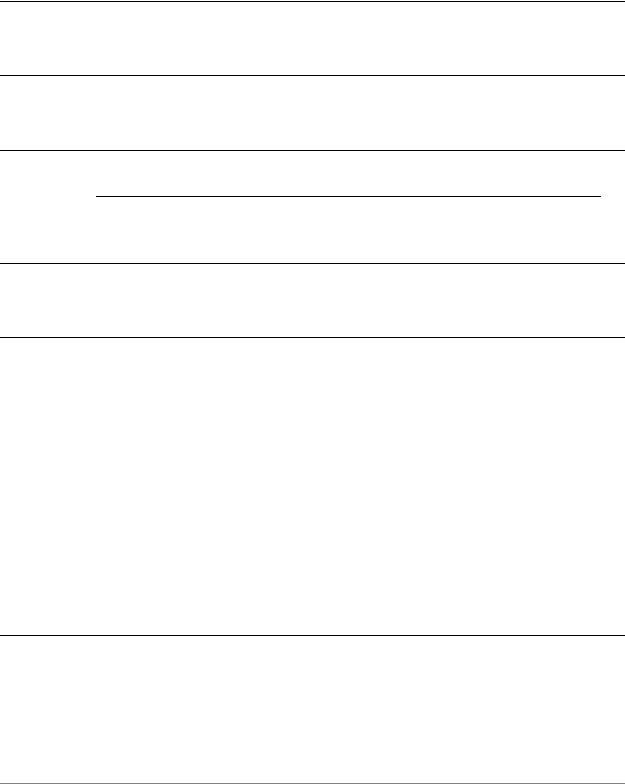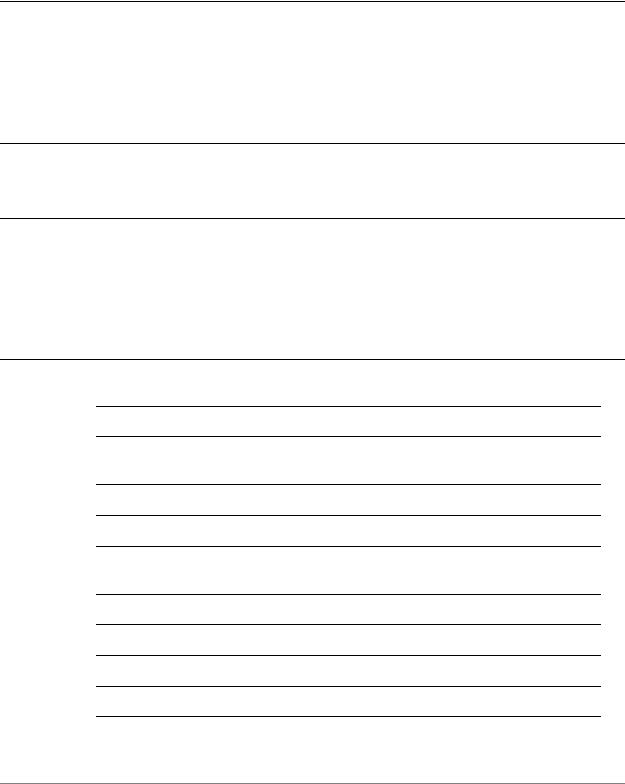
- •Table of Contents
- •Quick Reference to Commands
- •Quick List of Examples
- •Preface
- •Intended Audience
- •Organization of This Guide
- •Document Conventions
- •Vyatta Publications
- •Chapter 1: Serial Interfaces
- •Serial Interface Configuration
- •Virtual Interfaces on Serial Interfaces
- •Enabling Interfaces
- •Viewing Available Serial Interfaces
- •Serial Interface Commands
- •clear interfaces serial
- •interfaces serial <wanx>
- •interfaces serial <wanx> description <desc>
- •interfaces serial <wanx> encapsulation <type>
- •show interfaces serial
- •show interfaces serial <wanx>
- •show interfaces serial <wanx> capture
- •show interfaces serial <wanx> log
- •show interfaces serial <wanx> loopback
- •show interfaces serial <wanx> physical
- •show interfaces serial <wanx> ppp
- •show interfaces serial <wanx> queue
- •show interfaces serial <wanx> trace
- •Chapter 2: Testing Serial Lines
- •Serial Line Testing Overview
- •Serial Line Loopbacks
- •Loopback Tests
- •Bit Error Rate Tests
- •Serial Line Testing Commands
- •loopback down
- •loopback test
- •loopback up
- •Chapter 3: DSL Interfaces
- •DSL Configuration
- •ADSL Interfaces Overview
- •ADSL Configuration Example
- •DSL Commands
- •interfaces adsl <adslx>
- •interfaces adsl <adslx> watchdog <state>
- •Chapter 4: Wireless Modem Interfaces
- •Wireless Modem Configuration
- •Wireless Modem Interface Commands
- •clear interfaces connection <wlmx>
- •connect interface <wlmx>
- •disconnect interface <wlmx>
- •interfaces wirelessmodem <wlmx>
- •interfaces wirelessmodem <wlmx> backup
- •interfaces wirelessmodem <wlmx> description <desc>
- •interfaces wirelessmodem <wlmx> device <device>
- •interfaces wirelessmodem <wlmx> mtu <mtu>
- •interfaces wirelessmodem <wlmx> network <scriptfile>
- •interfaces wirelessmodem <wlmx> ondemand
- •show interfaces wirelessmodem
- •Glossary of Acronyms

Chapter 2: Testing Serial Lines |
Serial Line Testing Commands 89 |
|
|
|
|
loopback test
Starts a loopback test on a Sangoma T1/E1 or T3/E3 card.
Syntax
loopback test wanx
Command Mode
Operational mode.
Parameters
wanx |
The name of a serial interface. |
|
|
Default
None.
Usage Guidelines
Use this command to send data traffic on the line and check to see if the data is returned. The test succeeds if the data sent on the line is returned.
The test will not run unless the line is up.
NOTE For local and framer loopbacks, make sure the interface clocking is set to internal or the line will not come up due to lack of received clocking and the test will fail.
NOTE It may take up to 60 seconds after issuing a loopback up command before the loopback test command can be run successfully.
This test is usually performed to verify continuity from the local WAN interface out to the point where the circuit is looped back and back to the WAN interface. The test is typically performed on a line that is looped at the far end of the circuit, though the test should succeed if one of the system-facing loopbacks on the local WAN interface is active.
Examples
Example 2-6 shows the first screen of results for a successful loopback test on wan0.
WAN Interfaces |
R6.3 v01 |
Vyatta |

Chapter 2: Testing Serial Lines |
Serial Line Testing Commands 90 |
|
|
|
|
Example 2 6 Successful test of a loopback
vyatta@R1> loopback test wan0
Starting Loop Test |
(press ctrl c to exit)! |
||
Sep 10 |
04:34:39 | |
Test 0001 | Successful (Ok)! |
|
Sep 10 |
04:34:39 | |
Test 0002 | Successful (Ok)! |
|
Sep 10 |
04:34:40 | |
Test 0003 | Successful (Ok)! |
|
Sep 10 |
04:34:40 | |
Test 0004 |
| Successful (Ok)! |
Sep 10 |
04:34:41 | |
Test 0005 |
| Successful (Ok)! |
Sep 10 |
04:34:41 | |
Test 0006 |
| Successful (Ok)! |
Sep 10 |
04:34:42 | |
Test 0007 |
| Successful (Ok)! |
vyatta@R1>
Example 2-7 shows the first screen of results for an unsuccessful loopback test on wan0.
Example 2 7 Unsuccessful loopback test
vyatta@R1> loopback test wan0
Starting Loop Test (press ctrl c to exit)!
Sep 10 04:36:09 | |
Test 0001 | Timeout! |
||||||
Sep 10 |
04:36:09 | |
Test 0002 |
| Timeout! |
||||
Sep 10 |
04:36:10 | |
Test 0003 |
| Timeout! |
||||
Sep |
10 |
04:36:10 |
| |
Test |
0004 |
| |
Timeout! |
Sep |
10 |
04:36:11 |
| |
Test |
0005 |
| |
Timeout! |
vyatta@R1>
WAN Interfaces |
R6.3 v01 |
Vyatta |

Chapter 2: Testing Serial Lines |
Serial Line Testing Commands 91 |
|
|
|
|
loopback up
Activates a loopback on a Sangoma T1/E1 or T3/E3 card.
Syntax
loopback up wanx {analog | framer | line | local | payload}
Command Mode
Operational mode.
Parameters
wanx |
The name of a serial interface. |
|
|
analog |
Activate the Line Interface Unit analog loopback. This loopback |
|
loops data back to the system at the analog side of the Line |
|
Interface Unit within the Sangoma card. This parameter is |
|
available on Sangoma cards with Maxim and Exar chipsets. It is |
|
not available on cards with PMC-Sierra chipsets. |
|
|
framer |
Activate the framer loopback. This loopback loops data back to |
|
the system at the framer subsystem within the Sangoma card. |
|
This parameter is available only on Sangoma cards with Maxim |
|
chipsets. It is not available on cards with PMC-Sierra or Exar |
|
chipsets. |
|
|
line |
Activate the Line Interface Unit line loopback. This loopback |
|
loops data back to the line at the digital side of the Line Interface |
|
Unit. This parameter is available on Sangoma cards with |
|
Maxim, PMC-Sierra, and Exar chipsets. |
|
|
local |
Activate the Line Interface Unit local loopback. This loopback |
|
loops data back to the system at the digital side of the Line |
|
Interface Unit. This parameter is available on Sangoma cards |
|
with Maxim, PMC-Sierra, and Exar chipsets. |
|
|
payload |
Activate the payload loopback. This loopback loops data back |
|
to the line at the framer subsystem. This parameter is available |
|
only on Sangoma cards with Maxim and PMC-Sierra chipsets. |
|
It is not available on cards with Exar chipsets. |
|
|
WAN Interfaces |
R6.3 v01 |
Vyatta |

Chapter 2: Testing Serial Lines |
Serial Line Testing Commands 92 |
|
|
|
|
Default
None.
Usage Guidelines
Use this command to activate a serial loopback on a Sangoma T1/E1 or T3/E3 card. More than one loopback can be active at a time.
Once activated, a loopback remains active until it is deactivated by using a loopback down command, or when the interface is reconfigured, or when the system is rebooted. The status (up or down) of loopbacks activated with this command can be displayed using the physical option of show interfaces serial command.
Examples
Example 2-8 shows the system response to activating a local loopback.
Example 2 8 Activating a local loopback
vyatta@R1> loopback up wan0 local
Diagnostic Digital Loopback mode is activated!
vyatta@R1>
WAN Interfaces |
R6.3 v01 |
Vyatta |

Chapter 2: Testing Serial Lines |
Serial Line Testing Commands 93 |
|
|
|
|
test interface <wanx> start bert <test name>
Starts a saved bit error rate test.
Syntax
test interface wanx start-bert test-name [wait | watch]
Command Mode
Operational mode.
Parameters
wanx |
The name of the physical-layer T1 serial interface on which the |
|
BERT is to run. |
|
|
test-name |
The name of the saved BERT to use. |
|
|
wait |
Directs the system to retain control until test completion and not |
|
to generate output during the test. |
|
|
watch |
Directs the system to retain control until test completion but |
|
generate periodic messages. |
|
|
Default
Control returns immediately to the user and the test proceeds in the background.
Usage Guidelines
Use this command to start a bit error rate test (BERT) using the set of configuration parameters saved under the specified test name.
If the wait keyword is used, control is not returned to the user until after the test completes. In this case, no output is generated during the test.
If the watch keyword is used, control is still not returned to the user until after the test completes; however, the system prints periodic status messages about the test.
Regardless of whether keywords are used or not, the test can be terminated early by entering <Ctrl>+c or by issuing test interface <wanx> stop-bert command.
WAN Interfaces |
R6.3 v01 |
Vyatta |

Chapter 2: Testing Serial Lines |
Serial Line Testing Commands 94 |
|
|
|
|
Examples
Example 2-9 shows the system messages generated when the TEST1 BERT is run on wan0.
Example 2 9 Starting a BERT
vyatta@R1> test interface wan0 start bert TEST1
Execute BERT Start command... Done!
Running test in background for 120 seconds...
vyatta@R1>
WAN Interfaces |
R6.3 v01 |
Vyatta |

Chapter 2: Testing Serial Lines |
Serial Line Testing Commands 95 |
|
|
|
|
test interface <wanx> stop bert
Stops a bit error rate test that is in progress.
Syntax
test interface wanx stop-bert
Command Mode
Operational mode.
Parameters
wanx |
The name of the physical-layer T1 serial interface on which the |
|
BERT is being run. |
|
|
Default
None.
Usage Guidelines
Use this command to stop a bit error rate test (BERT) on the specified WAN interface.
If no test is in progress the system displays a message to that effect.
Examples
Example 2-10 shows the system messages generated when the BERT is running on wan0 is stopped.
Example 2 10 Stopping a BERT
vyatta@R1> test interface wan0 stop bert
Stopping BERT test running on interface wan0
Killing BERT test monitor process (pid 15339) ...Done. vyatta@R1>
WAN Interfaces |
R6.3 v01 |
Vyatta |

Chapter 2: Testing Serial Lines |
Serial Line Testing Commands 96 |
|
|
|
|
test definition bert <test name>
Defines a bit error rate test (BERT).
Syntax
set test-definition bert test-name
delete test-definition bert test-name
show test-definition bert test-name
Command Mode
Configuration mode.
Configuration Statement
test definition { bert test name {
}
}
Parameters
test-name Mandatory. Multi-node. The identifier for the BERT configuration that you are creating.
You can define any number of BERTs by creating multiple test bert configuration nodes.
Default
None.
Usage Guidelines
Use this command to define a named bit error rate test (BERT). BERT capability is currently available on Sangoma T1/E1 cards.
The saved test contains configuration parameters including the duration of the test, the bit stream pattern, the error insertion rate, and the method for activating and deactivate the serial loopbacks.
WAN Interfaces |
R6.3 v01 |
Vyatta |

Chapter 2: Testing Serial Lines |
Serial Line Testing Commands 97 |
|
|
|
|
To run the saved BERT, use the test interface <wanx> start-bert <test-name> command.
Use the set form of this command to create or modify a BERT. Use the delete form of this command to remove a BERT.
Use the show form of this command to view BERT configuration.
WAN Interfaces |
R6.3 v01 |
Vyatta |

Chapter 2: Testing Serial Lines |
Serial Line Testing Commands 98 |
|
|
|
|
test definition bert <test name> duration <duration>
Specifies the length of time for which a BERT is to run.
Syntax
set test-definition bert test-name duration duration delete test-definition bert test-name duration show test-definition bert test-name duration
Command Mode
Configuration mode.
Configuration Statement
test definition { bert test name {
duration duration
}
}
Parameters
test-name Mandatory. The name of a BERT.
duration The duration of the BERT, in seconds. The range is 1 to 4294967295. The default is 30.
Default
The test duration is 30 seconds.
Usage Guidelines
Use this command to specify the length of time (in seconds) the BERT is to run. Use the set form of this command to set the BERT duration.
Use the delete form of this command to restore the default BERT duration. Use the show form of this command to view BERT duration configuration.
WAN Interfaces |
R6.3 v01 |
Vyatta |

Chapter 2: Testing Serial Lines |
Serial Line Testing Commands 99 |
|
|
|
|
test definition bert <test name> err insert rate <rate>
Specifies the rate at which single-bit errors are inserted into the bit stream.
Syntax
set test-definition bert test-name err-insert-rate [10e-1 | 10e-2 | 10e-3 | 10e-4 | 10e-5 | 10e-6 | 10e-7 | none]
delete test-definition bert test-name err-insert-rate show test-definition bert test-name err-insert-rate
Command Mode
Configuration mode.
Configuration Statement
test definition { bert test name {
err insert rate rate
}
}
Parameters
test-name |
Mandatory. The name of a BERT. |
|
|
10e-1 |
Inserts bit errors at a rate of 10^1. This is the equivalent of 1 bit |
|
error for every 10 bits transmitted. |
|
|
10e-2 |
Inserts bit errors at a rate of 10^2. This is the equivalent of 1 bit |
|
error for every 100 bits transmitted. |
|
|
10e-3 |
Inserts bit errors at a rate of 10^3 (10 to the power of -3). This |
|
is the equivalent of 1 bit error for every 1,000 bits transmitted. |
|
|
10e-4 |
Inserts bit errors at a rate of 10^4 (10 to the power of -4). This |
|
is the equivalent of 1 bit error for every 10,000 bits transmitted. |
|
|
10e-5 |
Inserts bit errors at a rate of 10^5 (10 to the power of -5). This |
|
is the equivalent of 1 bit error for every 100,000 bits |
|
transmitted. |
|
|
WAN Interfaces |
R6.3 v01 |
Vyatta |

Chapter 2: Testing Serial Lines |
Serial Line Testing Commands 100 |
|
|
|
|
10e-6 |
Inserts bit errors at a rate of 10^6 (10 to the power of -6). This |
|
is the equivalent of 1 bit error for every 1,000,000 bits |
|
transmitted. |
|
|
10e-7 |
Insert bit errors at a rate of 10^7 (10 to the power of -7). This |
|
is the equivalent of 1 bit error for every 10,000,000 bits |
|
transmitted. |
|
|
none |
Do not insert bit errors. |
|
|
Default
No single-bit errors are inserted into the bit stream.
Usage Guidelines
Use this command to specify the rate that single-bit errors are inserted into the bit stream during a bit rate error test (BERT).
Use the set form of this command to specify the rate that single-bit errors are inserted into the bit stream.
Use the delete form of this command to remove the error insertion rate configuration.
Use the show form of this command to view the error insertion rate configuration.
WAN Interfaces |
R6.3 v01 |
Vyatta |

Chapter 2: Testing Serial Lines |
Serial Line Testing Commands 101 |
|
|
|
|
test definition bert <test name> loopup code <code>
Specifies the kind of loop-up code to send to the far end before a BERT.
Syntax
set test-definition bert test-name loopup-code [line | payload | none]
delete test-definition bert test-name loopup-code
show test-definition bert test-name loopup-code
Command Mode
Configuration mode.
Configuration Statement
test definition { bert test name {
loopup code code
}
}
Parameters
test-name Mandatory. The name of a BERT.
line |
Sends a loop-up code activating a “line” loopback. |
payload Sends a loop-up code activating a “payload” loopback.
none |
Does not send a loop-up code. This is the default. |
|
|
Default
No loop-up code is sent to the far end.
Usage Guidelines
Use this command to specify the loop-up code that is sent to equipment at the far end of a circuit.
The loop-up code is sent to the far end before a BERT begins. The loop-up code instructs the far end to activate a loopback and what kind of loopback to activate.
WAN Interfaces |
R6.3 v01 |
Vyatta |

Chapter 2: Testing Serial Lines |
Serial Line Testing Commands 102 |
|
|
|
|
When the system is configured to send a loop-up code, a corresponding loop-down code is sent to the far end at the end of the test to instruct it to deactivate the loopback.
Use the set form of this command to specify the loop-up code to be sent to the far end before a BERT begins.
Use the delete form of this command to restore default loop-up code configuration.
Use the show form of this command to view loop-up code configuration.
WAN Interfaces |
R6.3 v01 |
Vyatta |

Chapter 2: Testing Serial Lines |
Serial Line Testing Commands 103 |
|
|
|
|
test definition bert <test name> pattern <pattern name>
Specifies the bit pattern to be transmitted during a BERT.
Syntax
set test-definition bert test-name pattern pseudo-2e7 | pseudo-2e9 | pseudo-2e11 |
[3-in-24 | all-ones | all-zeros | daly | pseudo-2e15 | qrss]
delete test-definition bert test-name pattern
show test-definition bert test-name pattern
Command Mode
Configuration mode.
Configuration Statement
test definition { bert test name {
pattern pattern name
}
}
Parameters
test-name Mandatory. The name of a BERT.
3-in-24 Generates a repeating 24-bit pattern of 3 one-bits and 21 zero-bits.
all-ones Generates an all-ones bit pattern.
all-zeros Generates an all-zeros bit pattern.
daly Generates a repeating pattern of 55 octets in a sequence that changes rapidly between ones and zeros.
pseudo-2e7 Generates a pseudo-random bit-pattern 2^7 bits in length.
pseudo-2e9 Generates a pseudo-random bit-pattern 2^9 bits in length.
pseudo-2e11 Generates a pseudo-random bit-pattern 2^11 bits in length.
pseudo-2e15 Generates a pseudo-random bit-pattern 2^15 bits in length.
WAN Interfaces |
R6.3 v01 |
Vyatta |

Chapter 2: Testing Serial Lines |
Serial Line Testing Commands 104 |
|
|
|
|
qrss |
Generates a quasi-random signal source (QRSS) pattern, which |
|
is a pseudorandom binary sequence. This se que ce produces |
|
every combination of 20-bit words, repeats every 1,048,575 |
|
bits, and suppresses consecutive zeros to no more than 14. |
|
|
Default
A QRSS pattern is used.
Usage Guidelines
Use this command to specify the bit pattern to be transmitted during a bit rate error test (BERT).
Use the set form of this command to set the bit pattern.
Use the delete form of this command to restore the default bit pattern.
Use the show form of this command to view bit pattern configuration.
WAN Interfaces |
R6.3 v01 |
Vyatta |

Chapter 2: Testing Serial Lines |
Serial Line Testing Commands 105 |
|
|
|
|
test definition bert <test name> pattern <pattern name> alternating word
Allows you to define an alternating and repeating bit pattern for a BERT.
Syntax
set test-definition bert test-name pattern alternating-word [first-word pattern1| second-word pattern2 | repeat-count count]
delete test-definition bert test-name pattern alternating-word [first-word | second-word | repeat-count]
show test-definition bert test-name pattern alternating-word [first-word | second-word | repeat-count]
Command Mode
Configuration mode.
Configuration Statement
test definition { bert test name {
pattern pattern name { alternating word {
first word pattern1 second word pattern2 repeat count count
}
}
}
}
Parameters
test-name Mandatory. The name of a BERT.
pattern1 The first 16-bit word of the alternating pattern, specified in hexadecimal without a leading “0x”; for example, “2ea7.”
pattern2 The second 16-bit word of the alternating pattern, specified in hexadecimal without a leading “0x”; for example, “2ea7.”
WAN Interfaces |
R6.3 v01 |
Vyatta |

Chapter 2: Testing Serial Lines |
Serial Line Testing Commands 106 |
|
|
|
|
count |
The number of times each word is to be transmitted before |
|
sending the other word. For example, a repeat count of 1 means |
|
that the first word is sent once, then the second word is sent |
|
once, then the process is repeated. A repeat count of 2 means |
|
that the first word is sent twice, then the other word is sent |
|
twice, then the process is repeated. The range is 1 to 256. The |
|
default is 1. |
|
|
Default
When this option is not set, alternating work patterns are not used.
Usage Guidelines
Use this command to define an alternating and repeating pattern of 16-bit words to be used as a bit pattern in a bit rate error test (BERT).
If an alternating word pattern is not specified, the BERT uses the pattern specified by the test-definition bert <test-name> pattern <pattern-name> command.
Use the set form of this command to define an alternating word pattern.
Use the delete form of this command to remove alternating word pattern configuration.
Use the show form of this command to view alternating word pattern configuration.
WAN Interfaces |
R6.3 v01 |
Vyatta |

Chapter 2: Testing Serial Lines |
Serial Line Testing Commands 107 |
|
|
|
|
test definition bert <test name> pattern <pattern name> repeating
Allows you to define a repeating bit pattern for a BERT.
Syntax
set test-definition bert test-name pattern repeating [word pattern | length-in-bits length]
delete test-definition bert test-name pattern repeating [word | length-in-bits] show test-definition bert test-name pattern repeating [word | length-in-bits]
Command Mode
Configuration mode.
Configuration Statement
test definition { bert test name {
pattern pattern name { repeating {
word pattern length in bits length
}
}
}
}
Parameters
test-name |
Mandatory. The name of a BERT. |
|
|
word pattern |
A 32-bit pattern, specified in hexadecimal without a |
|
leading “0x”; for example, “2ea732a5.” If fewer |
|
than 8 hexidecimal digits are provided, the |
|
high-order (left-most) digits are padded with zeros. |
|
|
length-in-bits length |
The length of the bit pattern. This number of |
|
low-order bits from the specified pattern is repeated. |
|
The range is 1 to 32. The default is 32. |
|
|
WAN Interfaces |
R6.3 v01 |
Vyatta |

Chapter 2: Testing Serial Lines |
Serial Line Testing Commands 108 |
|
|
|
|
Default
None.
Usage Guidelines
Use this command to define a repeating pattern of up to 32 bits to be used as the bit pattern in a BERT.
Use the set form of this command to create or modify a repeating bit pattern. Use the delete form of this command to remove repeating bit pattern.
Use the show form of this command to view repeating bit pattern.
WAN Interfaces |
R6.3 v01 |
Vyatta |
